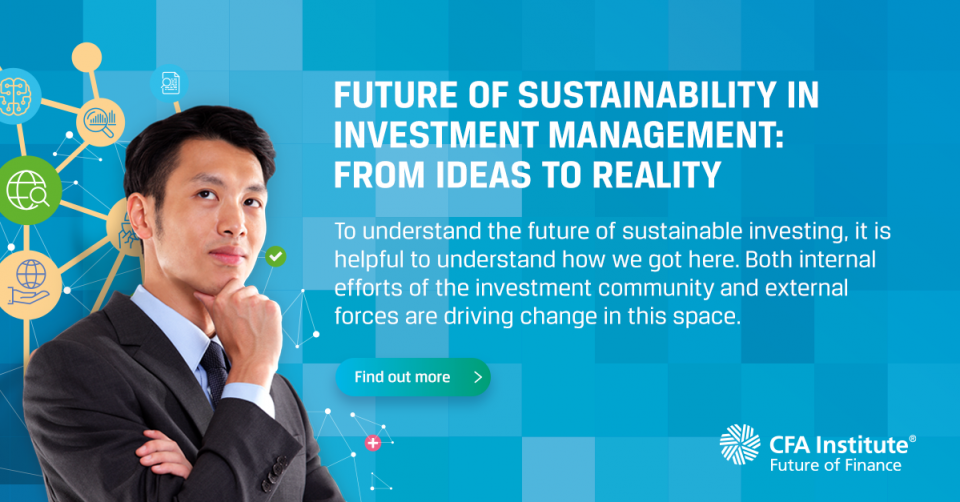
Sustainability investing: what does the future look like?

‘Future of Sustainability in Investment Management: From Ideas to Reality’ is a newly published CFA Institute report. The 60-page publication was informed by the views of more than 7,000 industry participants, including 3,500+ retail investors, 920+ asset owners and 3,050+ investment practitioners. Research included virtual roundtables across 31 markets. Here we summarise its findings.
The future of sustainable investing is in the balance. It involves balancing financial and extra-financial considerations, short-term and long-term goals, and interests among stakeholders and over time, while seeking fair outcomes for all. This is not easy. But sustainable investing is critical to the sustainability of investing. The incorporation of sustainability in investment management is an important element in the industry’s mission to serve society by improving long-term outcomes.
Although the future of sustainable investing includes many unknowns, our publication advances three important tenets where sustainable investing goes further than its forerunners:
- It is additive to investment theory and does not mean a rejection of foundational concepts.
- It develops deeper insights about how value will be created going forward using environmental, social, and governance (ESG) considerations.
- It considers many stakeholders.
In many ways, we are moving from sustainable investing as a good idea to a reality that has implications for all investment portfolios. There is a growing recognition that some ESG factors are economically material, especially in the long term, and it is, therefore, important to integrate material ESG factors in investment decisions.

Research reveals top trends
CFA Institute considers a five- to 10-year time horizon and the report’s structure follows the acronym ‘IDEA’.
Influences – the accelerating demand for sustainable investing and scenarios for the future.
Drivers – how investment organisations are adapting and expanding their business models and investment models to meet investor expectations for sustainable investing.
Enablers – how the operating models and people models of investment organisations will facilitate growth in sustainable investing.
Actions – a rubric for investment organisations, investment professionals and the industry to support the pathway of sustainable investing.
CFA Institute suggests that the next stage of development will depend very heavily on industry leadership and innovation in investment thinking and practice, as well as data management. Investors and the investment industry have a considerable role to play in shaping the future. Here we briefly outline some of the key findings in each of the report’s ‘I’, ‘D’, ‘E’ and ‘A’ sections.
Influences – how sustainable investing’s growth is accelerating
In the first half of 2020 alone, Principles for Responsible Investment (PRI) signatories increased by 28%, to more than 3,000 entities, and assets under management grew 20%, to more than $100 trillion (about £74.7 trillion).
Eighty-five per cent of CFA Institute members now take E, S and/or G factors into consideration in their investing, up from 73 per cent in 2017.
Client demand as a motivation for investment organisations to consider ESG factors increased significantly in the past three years. Demand as a motivator was highest in the Americas region (65%), an increase of 20 per cent since 2017.
According to Google Trends, the topic ‘environmental, social and corporate governance’ has never been as popular as it is today.
Covid-19 has focused investors on the vulnerability and resilience of the financial system and intensified the discussions around sustainability.
Drivers – how business models are adapting
The business model for investment organisations pursuing sustainable investing must make commitments on the full range of resources, processes and incentives that are necessary to drive an innovation of this magnitude.
Although only 19% of institutional investors and 10% of retail investors currently invest in products that incorporate ESG factors, 76% of institutional investors and 69% of retail investors have interest in ESG investing.
Among those with a values objective (or a dual objective combining financial outcomes with values), 73% of institutional investors and 67% of retail investors would be willing to give up some return in exchange for meeting their values objective.
The most-used features for survey respondents are best-in-class/positive screening (used by 56%) and ESG integration (53%), followed by ESG-related exclusions (48%).
In respect of expected growth areas, professionals expect to see more ESG index tracking and quant funds, ESG thematic products, ESG multi-asset products, climate transition strategies, long-term engagement and better benchmarks.
Enablers – how organisations are managing products and services
Company ratings are widely used, with 63% of investment professional respondents using them as a part of their data analysis. In addition, 73% expect the influence of ESG ratings on firms’ cost of capital to be greater in the next five years.
Forty per cent of investment professionals surveyed incorporate climate risk into their analysis, and the most common types of risk considered are physical and transition risks.
Seventy-eight per cent of practitioners believe there is a need for improved standards around ESG products to mitigate ‘greenwashing’.
A majority (71%) of industry roundtable participants agreed that alternative data have the potential to improve the robustness of sustainability analysis, and 43% expect sustainability to benefit from the application of artificial intelligence.
Ninety per cent of investment professionals expect their firm’s commitment to ESG research will increase, up from 72 per cent just two years ago.
Actions – how the investment industry should respond
We suggest that the industry must make a transition toward increased adoption of sustainable investing.
A rubric for progress provides a framework to produce a combination of a grade for performance and a guide to improve performance. The guide we suggest for improving performance includes the following elements for the industry, organisations and investment professionals.
- ESG education
- System-level thinking
- Collaboration synergy
- ESG data
- Sustainability innovation
- Purposeful culture
What’s next?
As the largest global association of investment professionals, CFA Institute has committed to the development of sustainable investing in the following ways:
- Supporting company reporting efforts by providing the investor view on advisory committees and working with accounting standard setters to look for harmonisation opportunities.
- Educating investment professionals via a specialist certificate, professional development, practitioner-focused research and the CFA Program curriculum. In the next edition of the curriculum, ESG content will increase by 130%, with 23 readings in seven topic areas. This is equivalent to ESG coverage in 16% of readings, and ESG coverage will likely reach 20% or more as ESG standards develop and practice advances.
- Creating standards to improve product transparency and comparability in investor reporting, with the CFA Institute ESG Disclosure Standards for Investment Products expected in late 2021.
Within sustainable investing lie the fundamental elements of the sustainability of investing. Investors and the investment industry have a considerable role to play in determining the pathway and shaping a future worth investing in.
Interested to learn more about the topics discussed here? Check out the full ‘Future of Sustainability in Investment Management: From Ideas to Reality’ report.

Authors:
Rebecca Fender, CFA
Robert Stammers, CFA
Roger Urwin, FSIPliv
Rhodri Preece, CFA, Editor
Image credits: ©Getty Images/Filograph and CFA Institute Archive